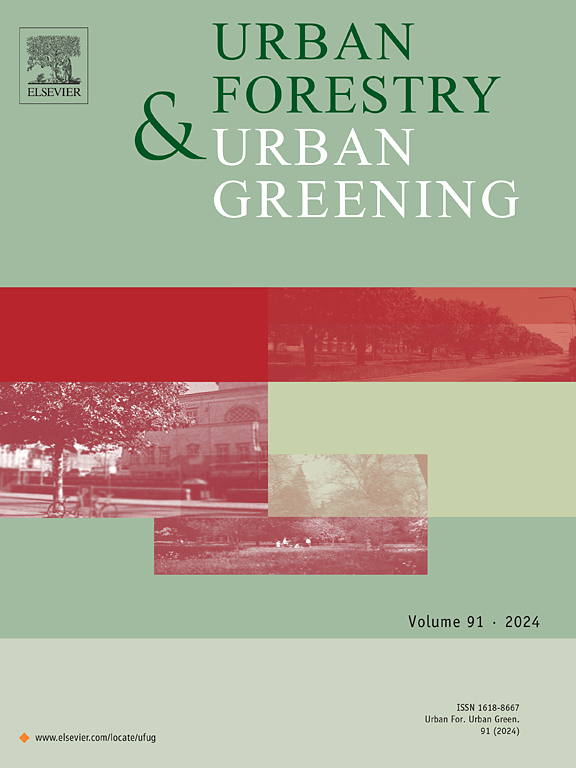Renaturalisation and natural rewilding of the Manzanares river in Madrid, Spain: Mapping recreation potential and actual use
IF 6
2区 环境科学与生态学
Q1 ENVIRONMENTAL STUDIES
引用次数: 0
Abstract
Urbanisation has impaired the capacity of urban rivers to provide ecosystem services. In the last decades, many river restoration projects have been carried out worldwide with the objective of recovering ecological integrity and the provision of a wide range of ecosystem services. In this paper we analyse the impact of the renaturalisation of the Manzanares river in Madrid, Spain, in the attractiveness of the surrounding green space for outdoor recreation. Two complementary mapping methodologies, ESTIMAP-recreation model and public participation geographical information systems (PPGIS), were used to analyse recreation potential and actual use. The results show that the renaturalisation of the river has improved ecological quality as well as recreational attractiveness, increasing the capacity to provide a wide range of ecosystem services. Both methodologies produce complementary results. The areas close to the river are those with the highest recreation potential. However, actual use is not only conditioned by recreation potential but also by proximity to the place of residence, accessibility, security, and other landscape characteristics that could not be captured by ESTIMAP model, such as sense of place. We conclude that even in highly modified urban rivers, renaturalisation with low-cost actions can highly improve the capacity to provide ecosystem services and recommend using complementary methodologies to capture the diversity of user preferences for outdoor recreation to design urban green spaces.
西班牙马德里曼萨纳雷斯河的重新归化和自然野化:绘制娱乐潜力和实际使用图
城市化削弱了城市河流提供生态系统服务的能力。在过去的几十年中,世界各地开展了许多河流恢复项目,目的是恢复生态完整性并提供广泛的生态系统服务。在本文中,我们分析了西班牙马德里曼萨纳雷斯河再自然化对周边绿地户外休闲吸引力的影响。我们采用了两种互补的绘图方法,即ESTIMAP-娱乐模型和公众参与地理信息系统(PPGIS),来分析娱乐的潜力和实际使用情况。结果表明,河流的再自然化改善了生态质量和娱乐吸引力,提高了提供各种生态系统服务的能力。这两种方法产生了互补的结果。靠近河流的区域具有最大的娱乐潜力。然而,实际使用情况不仅取决于娱乐潜力,还取决于与居住地的距离、可达性、安全性以及 ESTIMAP 模型无法捕捉的其他景观特征,如地方感。我们的结论是,即使在高度改造的城市河流中,通过低成本行动进行再自然化也能极大地提高提供生态系统服务的能力,并建议使用补充方法来捕捉用户对户外休闲的不同偏好,从而设计城市绿地。
本文章由计算机程序翻译,如有差异,请以英文原文为准。
求助全文
约1分钟内获得全文
求助全文
来源期刊

Urban Forestry & Urban Greening
FORESTRY-
CiteScore
11.70
自引率
12.50%
发文量
289
审稿时长
70 days
期刊介绍:
Urban Forestry and Urban Greening is a refereed, international journal aimed at presenting high-quality research with urban and peri-urban woody and non-woody vegetation and its use, planning, design, establishment and management as its main topics. Urban Forestry and Urban Greening concentrates on all tree-dominated (as joint together in the urban forest) as well as other green resources in and around urban areas, such as woodlands, public and private urban parks and gardens, urban nature areas, street tree and square plantations, botanical gardens and cemeteries.
The journal welcomes basic and applied research papers, as well as review papers and short communications. Contributions should focus on one or more of the following aspects:
-Form and functions of urban forests and other vegetation, including aspects of urban ecology.
-Policy-making, planning and design related to urban forests and other vegetation.
-Selection and establishment of tree resources and other vegetation for urban environments.
-Management of urban forests and other vegetation.
Original contributions of a high academic standard are invited from a wide range of disciplines and fields, including forestry, biology, horticulture, arboriculture, landscape ecology, pathology, soil science, hydrology, landscape architecture, landscape planning, urban planning and design, economics, sociology, environmental psychology, public health, and education.
 求助内容:
求助内容: 应助结果提醒方式:
应助结果提醒方式:


